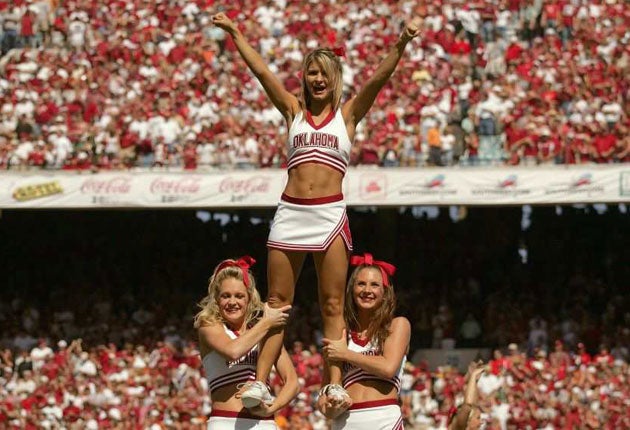Obama's first power play: College football leagues
They're corrupt and over-complicated – but if the President-elect thinks he can shake-up America's college football leagues, he's picking a fight he can't win. Rupert Cornwell on a multi-billion-dollar minefield

Make Hillary Secretary of State? Rescue the American car industry? Bail out the national banking system? Barack Obama may do all these things and more. But one thing he can't do: mess with college football.
Think what, in Britain, would be called university sport, and what comes to mind is a few hundred spectators scattered round a muddy soccer field, or a gentle ripple of applause from the deckchairs when some Oxford chap makes a nice cover drive. All very polite and indubitably amateur. Not so in the US.
College sport there is huge – and none is huger than football, a multi-billion-dollar industry that in some parts of the country is even more beloved than the National Football League (which as it never tires of bragging, is the richest sports league on the planet: take that, Premier League).
Thus the shock waves when Obama, at the end of an otherwise uneventful debut interview as President-elect, suggested that college football might follow the example of every other major league and college sport in the US, and establish a series of playoffs between the top teams, to produce an agreed national champion.
The furore has yet to die down. "I don't know any serious fan of college football who disagrees with me on this," Obama told CBS 60 minutes. Well, he might start by reading the sports columnists who've been sputtering with outrage at the notion for the past week. Their case in short is, if it ain't broke, don't fix it.
As currently organised, college football consists of a number of regional "conferences" (we'd call them leagues), graded by divisions. Then, by a mysterious process far too complex to explain here, the top teams are paired off for post-season "bowl games" – so named because of the shape of the stadium in Pasadena, just outside Los Angeles, where the Rose Bowl, the oldest and most famous of them all, is played every New Year's Day.
Right now the 12-game regular season is approaching its climax. Then come the bowl games, 34 in all this year. Finally, by a further strange osmosis, two teams emerge for a "national championship game". But rarely is the winner reckoned to be unarguably the best college team of the season.
The beauty of US college football is that there are dozens of winners. Obama, the cerebral product of Columbia and Harvard, may be appalled at the illogicality of the existing system. But everyone else loves it: the fans who can quarrel over the respective merits of the top teams, the sports columnists who have something to rant about, and naturally the colleges. For who doesn't want to get a slice of a multi-billion-dollar pie?
The NCAA, the vastly powerful governing body for college sport in the US, pretends to be the guardian of a noble Corinthian tradition, whereby the players perform merely for joyous love of the game, that sport is an innocent sideline at great seats of learning. A few mind-boggling figures will dispose of these fantasies.
At Ohio State University the total athletic budget, admittedly the largest for any US college, was no less than $110m (£74m) last year, of which American football accounted for a large portion. But the money was well spent. The OSU football team generates over $60m in annual revenue. Or take the stadiums. The OSU arena holds 90,000 fans, as many as Wembley. But four Division One teams have larger stadiums, seating over 100,000 people. Seats for a game can cost $50 or more, with surcharges of up to $500 for the best seats at the biggest games.
Then there are the TV contracts. This year the networks signed a $2.5bn, 15-year deal with the South East Conference (SEC), just one of several top conferences. The contract covers several sports, but far and away the most important is football. On top of that are the bowl games, attracting lavish corporate sponsorship and netting some $300m last year for the colleges involved. A successful football team therefore is a cash cow – and not surprisingly competition for the best players and the best coaches is anything but gentlemanly. Desperate to revive its fortunes, SEC member University of Alabama last year signed Nick Saban (formerly of the Miami Dolphins) as its coach on a $32m, eight-year contract.
Saban is the best rewarded of the lot; his deal includes two cars, a country club membership and 25 hours' use of a private jet each year. That $4m (£2.7m) annual salary may seem a trifle excessive – until you learn that 92,000 fans turned up for his first practice game in charge of the Crimson Tide team.
The only people who (theoretically) don't get paid are the ones those fans wanted to watch, the student players themselves. But of course they get all-in scholarships – even if they don't pick up a book all term.
Then there's the less conventional remuneration. Tales regularly crop up of illegal "booster" payments from fans to the players, while recruitment can be an even more underhand business: a couple of years ago a high school football coach was paid a $150,000 "booster" from an Alabama fan to point his best player in the direction of the Crimson Tide.
For better or worse, college football is part of American culture. That's why, a couple of years back, Secretary of State Condoleezza Rice thought she could offer our Foreign Secretary Jack Straw no bigger treat than to take him to watch the Crimson Tide, in her native Alabama. And that's why Obama can't mess with it.
Join our commenting forum
Join thought-provoking conversations, follow other Independent readers and see their replies
Comments
Bookmark popover
Removed from bookmarks